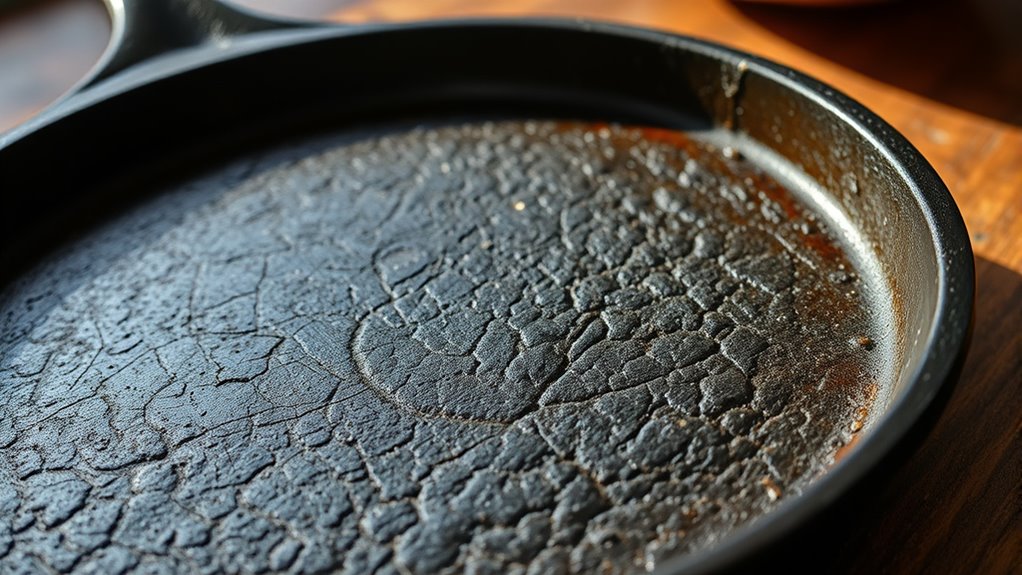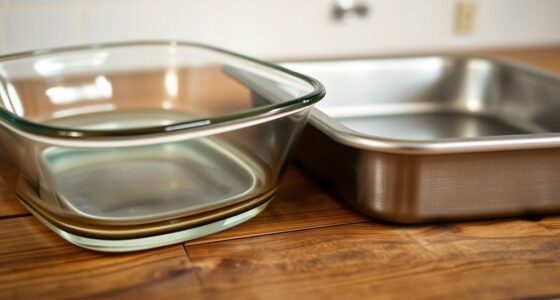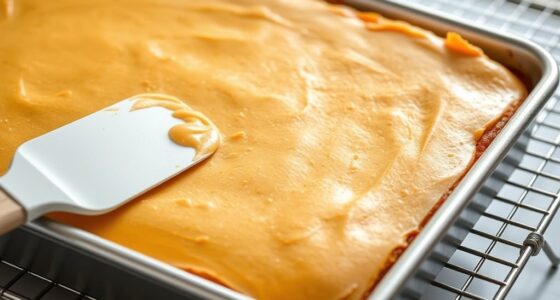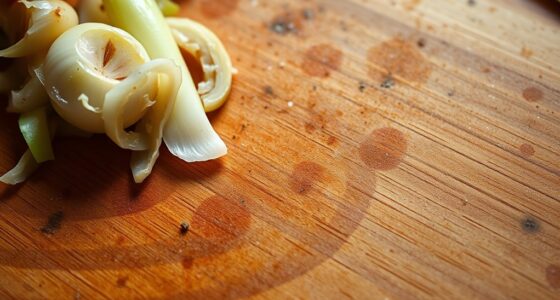If you’re looking for a cookware material that’s over 300 years old and outperforms modern options, seasoned cast iron is your answer. It offers unmatched durability, natural non-stick safety, and excellent heat retention. Unlike synthetic coatings that wear out or can leach chemicals, seasoned cast iron gets better with age, lasting generations. To discover how this time-tested material can elevate your cooking, keep exploring the many benefits of traditional cast iron.
Key Takeaways
- Traditional cast iron and copper cookware can last over 300 years with proper care, outlasting most modern options.
- Their natural, polymerized oil layers create a durable, chemical-free non-stick surface that improves over time.
- These materials offer superior heat retention and even distribution, enhancing cooking performance for generations.
- Proper seasoning and maintenance prevent rust and preserve their non-stick properties, ensuring long-term durability.
- Their eco-friendly manufacturing and longevity make them a sustainable alternative to disposable or synthetic cookware.
The History of Seasoned Cast Iron and Its Origins
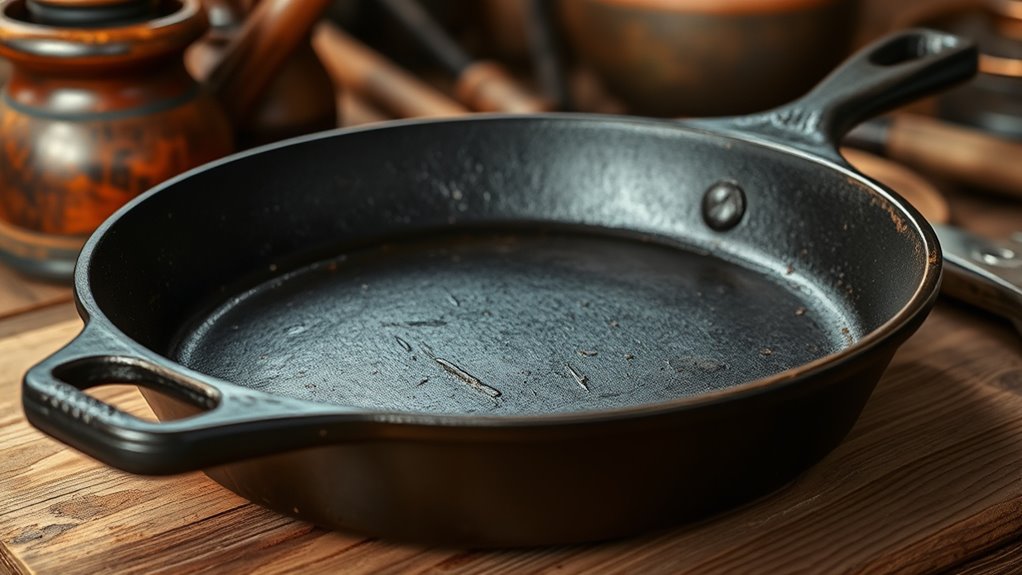
The history of seasoned cast iron dates back over 2,000 years, with ancient civilizations like the Romans and Chinese discovering that iron vessels could become more durable and non-stick through repeated use. They developed the seasoning process by applying fat and heating it, creating a natural non-stick surface that improved with each use. This technique made cast iron highly rust-resistant and reliable as traditional cookware. In early America, colonists relied on seasoned cast iron pots and skillets, building up layers of polymerized fat that enhanced performance and longevity. Today, seasoned cast iron remains a cherished heritage cookware, passed down through generations. Its durability, natural non-stick qualities, and resistance to rust make it a timeless choice for cooking enthusiasts worldwide. Proper seasoning techniques are essential for maintaining the non-stick surface and preventing rust over time.
Benefits of Natural Non-Stick Properties in Cast Iron
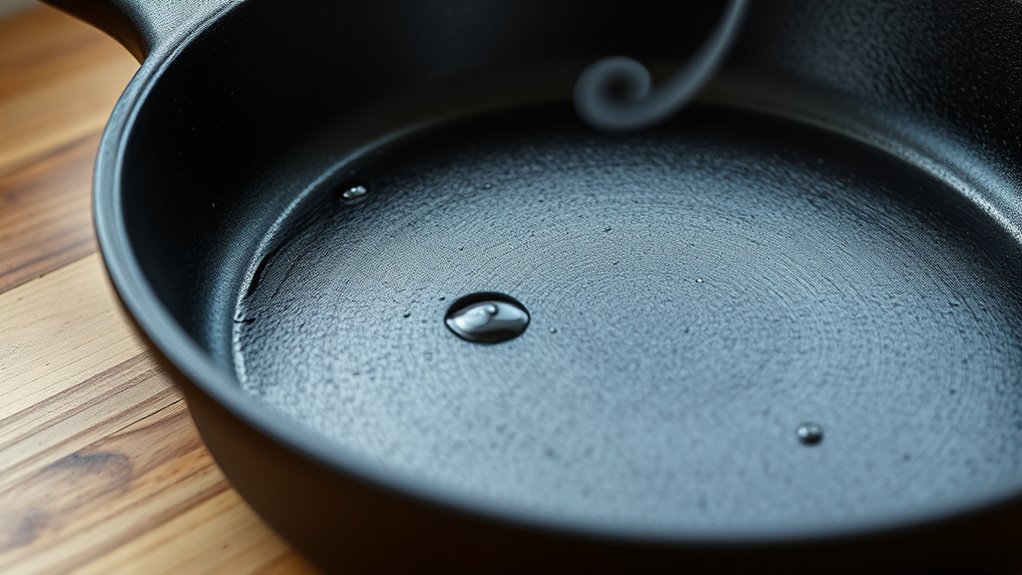
Natural non-stick properties in cast iron offer a remarkable advantage over synthetic coatings, allowing you to cook delicate foods like eggs and pancakes with minimal sticking. When you build seasoning on your cast iron, a polymerized oil layer forms, creating a durable, chemical-free non-stick surface that improves with each use. Seasoned cast iron boasts excellent non-stick properties, so you can cook with less oil and enjoy easier cleanup. Its high heat retention ensures even heating, giving you consistent results every time. Unlike synthetic non-stick coatings that degrade, the natural non-stick layer in cast iron gets better over time, enhancing durability and performance. This long-lasting, chemical-free non-stick surface makes cast iron a safe, sustainable choice for everyday cooking. Additionally, proper appliance maintenance plans can help preserve your cookware by ensuring your stove and oven operate efficiently, preventing damage and extending the lifespan of your kitchen appliances. Regular seasoning also helps maintain the seasoned surface, boosting its non-stick qualities over years of use. Moreover, understanding the types of headphone jacks can enhance your audio experience when using cast iron cookware with audio guides or instructional videos. Recognizing how the layered structure of cast iron contributes to its durability can further inform your care practices, ensuring it remains a reliable kitchen tool for generations. Proper care practices can also help prevent seasoning damage, maintaining the cookware’s non-stick properties and extending its longevity.
Durability and Longevity of Traditional Cookware Materials
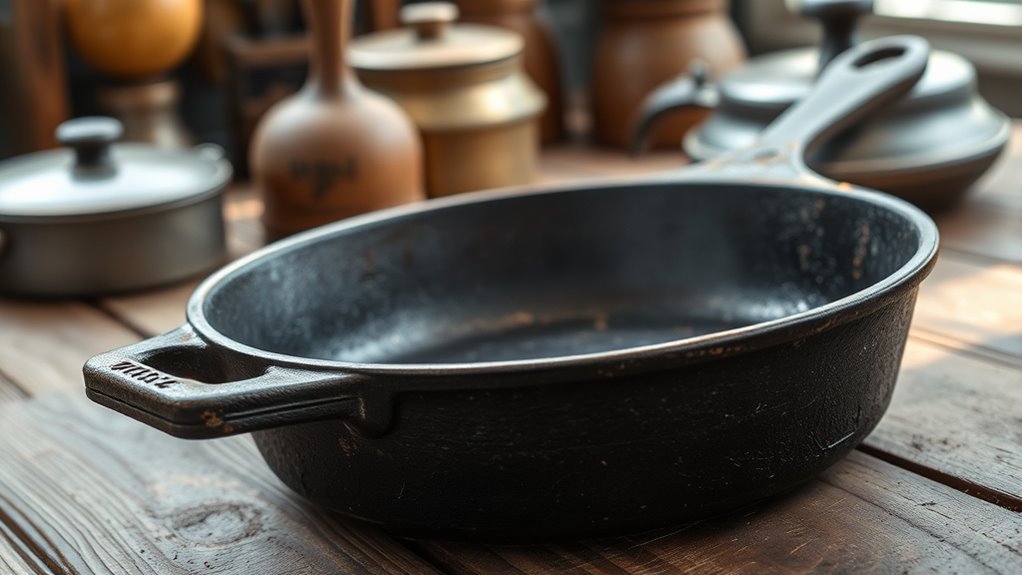
Many traditional cookware materials, like cast iron and copper, are renowned for their incredible durability, often lasting for centuries when properly cared for. Cast iron, when seasoned and maintained, develops a natural non-stick surface that improves with age, ensuring long-term performance. Its durability allows it to become a treasured heirloom, passed down through generations. Copper cookware, especially when lined with tin or stainless steel, maintains its appearance and functionality for over 300 years, demonstrating exceptional longevity. Historical examples show that well-preserved pieces from the 17th and 18th centuries remain fully functional today. Proper cleaning, seasoning, and storage are essential to preserving this durability, ensuring your traditional cookware continues to perform reliably over centuries. Additionally, using seasoning and maintenance techniques can significantly extend the lifespan of these cookware materials, and understanding traditional craftsmanship can help in proper care and restoration.
Chemical-Free Cooking: Why Seasoned Cast Iron Is Safer
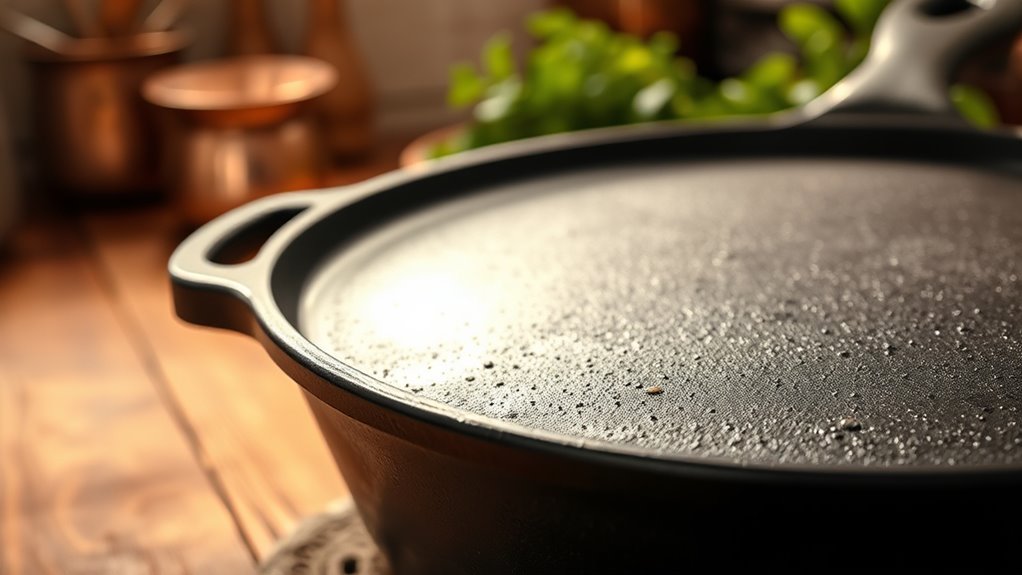
Seasoned cast iron offers a chemical-free cooking surface that’s both safe and reliable. Over time, natural seasoning develops a non-stick surface from polymerized oils, eliminating the need for synthetic coatings. Unlike non-stick pans that may contain PTFE or PFOA chemicals, seasoned cast iron is free from harmful chemicals, making it safer for high-temperature cooking. Imagine:
Seasoned cast iron provides a safe, chemical-free, non-stick cooking surface that is durable and free from harmful synthetic coatings.
- A skillet with a smooth, dark patina that prevents sticking without synthetic layers.
- Food cooked directly on a surface that doesn’t leach chemicals into your meal.
- A durable cookware that resists chipping or degrading over time, maintaining safety and performance.
- The color accuracy of seasoned cast iron remains stable over years, ensuring consistent cooking results.
- Its natural composition minimizes the risk of chemical leaching when cooking acidic foods, supporting healthier meals.
Because it’s made from natural iron, seasoned cast iron avoids chemical reactions with acidic foods, reducing the risk of chemical leaching and supporting healthier cooking.
Heat Conductivity and Distribution in Cast Iron Pans
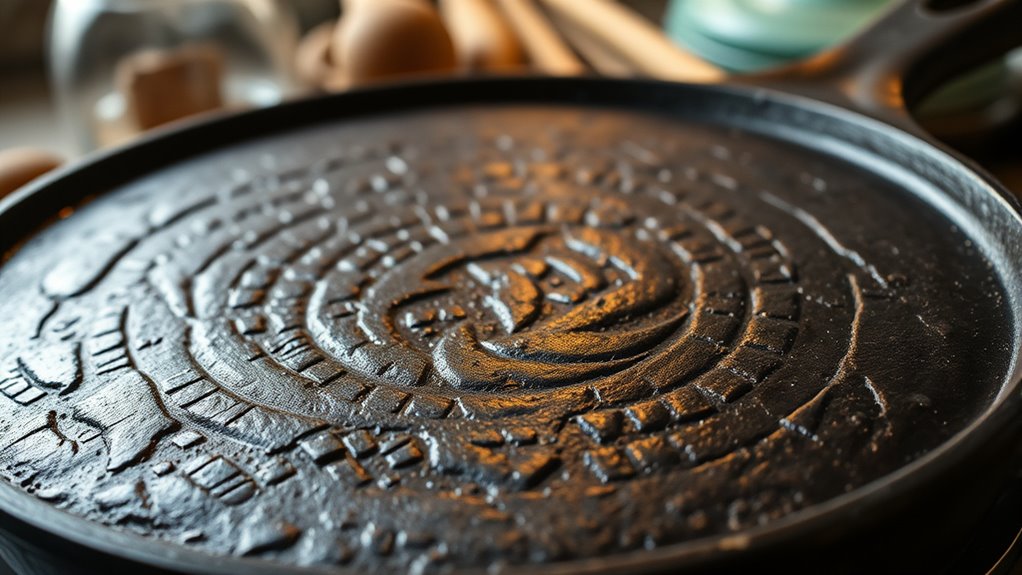
Cast iron pans excel at evenly distributing heat across their thick, dense surfaces, which helps prevent hot spots during cooking. This is due to their high thermal mass, allowing them to retain heat and provide consistent temperature control. The heat conduction of cast iron improves with seasoning, creating a naturally non-stick surface that enhances heat transfer. Unlike thinner cookware, cast iron’s ability to spread heat evenly results in uniform browning and better cooking results. Its excellent heat retention means it stays hot longer, making it ideal for searing and slow-cooking. Because of its superior heat distribution and conduction, you don’t need to crank up the flame, leading to more energy-efficient cooking. Additionally, automation technologies in manufacturing processes have contributed to the improved quality and affordability of cast iron cookware over time. Overall, cast iron’s thermal properties make it a reliable choice for consistent, high-quality results.
Maintenance and Care to Extend the Life of Cast Iron
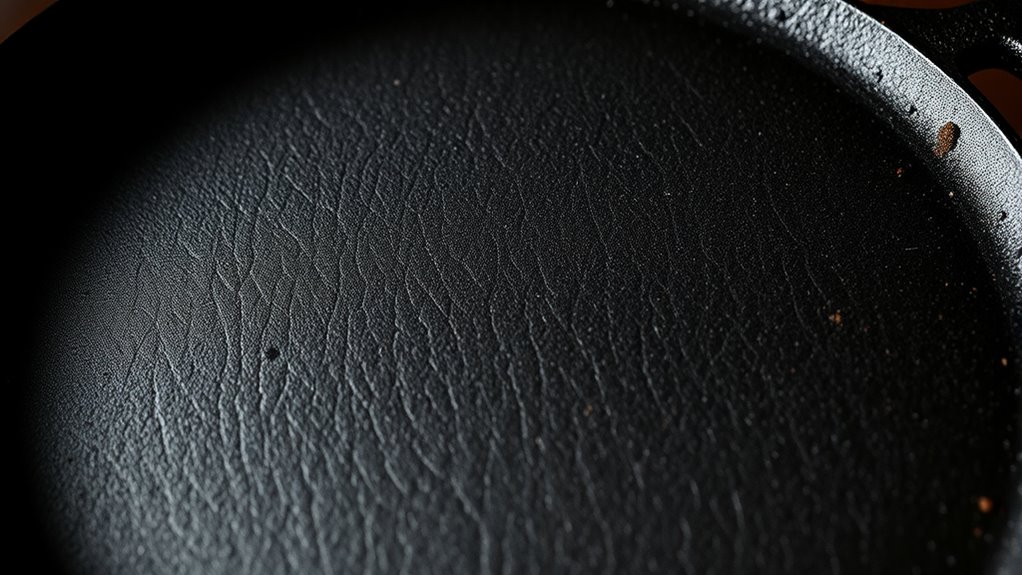
To keep your cast iron pan in ideal condition, proper maintenance is essential. First, always dry it immediately after washing to prevent rust and preserve the seasoning. Second, regularly apply a thin layer of oil and bake it in the oven to build and maintain a durable, non-stick patina that improves over time. Third, store your cast iron in a dry place, placing a paper towel inside to absorb moisture and prevent rust. When cleaning, avoid soap and abrasive scrubbers, which can strip the seasoning. Instead, use hot water and a soft brush. Re-season your pan periodically by coating it with oil and heating it at 400-450°F for an hour to restore its non-stick qualities. Proper maintenance guarantees your cast iron remains durable and functional for generations. Additionally, understanding vibrational energy can help you manifest better care routines and long-lasting cookware. Incorporating mindful cleaning techniques can further enhance the longevity of your cast iron and keep it performing at its best, especially when combined with consistent seasoning practices that strengthen the cookware’s protective layer. Being aware of temperature control during cooking can also prevent damage and preserve the seasoning.
Environmental and Sustainability Aspects of Cast Iron Cookware
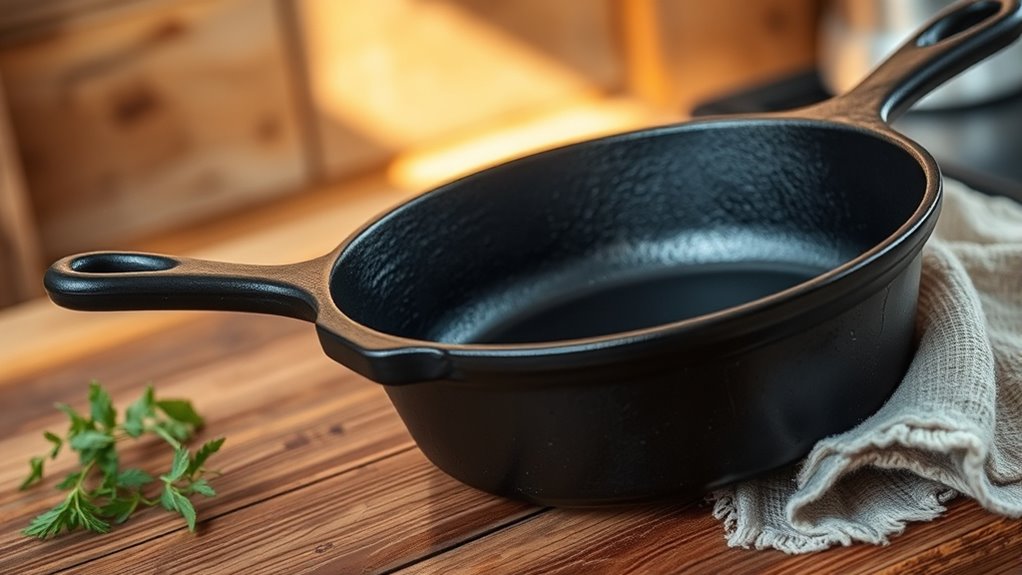
Proper maintenance not only extends the life of your cookware but also makes it an environmentally friendly choice. Cast iron’s durability ensures it remains long-lasting, reducing the need for frequent replacements and minimizing waste. Its traditional manufacturing processes have changed little over centuries, lowering the environmental impact compared to mass-produced, disposable cookware. Because cast iron is so durable, it contributes to sustainability by requiring fewer resources over time. Low waste is achieved through regional production, often in American factories, which reduces transportation emissions and supports local economies. When seasoned and cared for properly, cast iron requires no chemical coatings or non-stick chemicals, further lowering environmental pollution and health risks. Additionally, ongoing research in AI Security aims to develop safer and more sustainable manufacturing methods for traditional materials like cast iron. Overall, cast iron’s sustainability benefits make it a smart, eco-conscious addition to your kitchen.
Comparing Seasoned Cast Iron With Modern Non-Stick Options
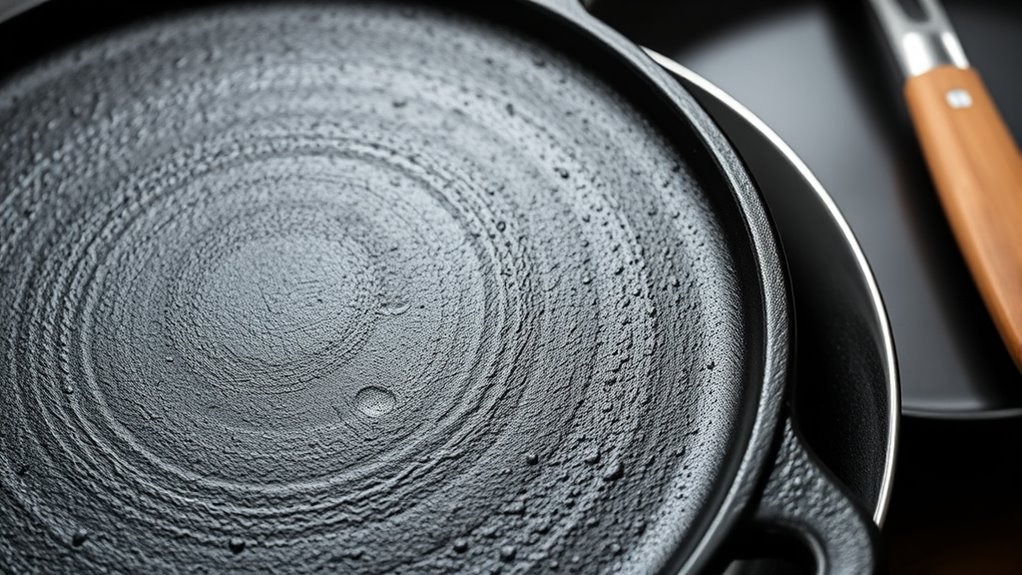
While modern non-stick pans offer convenience with their easy-release surfaces, seasoned cast iron provides a durable, natural alternative that can last for decades. Imagine:
- A sturdy metal cookware that develops a smooth, non-stick surface over time through polymerized oils.
- A piece of chemical-free cookware free from toxic PTFE and PFOA, safe for traditional cooking.
- An oven-safe tool with superior heat retention, perfect for searing, baking, or slow-cooking.
- Proper storage and regular maintenance, such as seasoning techniques, help enhance its longevity and performance. Additionally, the long-lasting durability of cast iron makes it an investment that pays off over generations. Cast iron’s heat retention properties enable more consistent cooking results across various recipes. Over time, the surface becomes more non-stick, improving with each use and reducing the need for additional fats or oils.
Unlike non-stick coatings that wear out after a few years, seasoned cast iron improves with use, becoming more durable and smoother. Its even heating makes it versatile, and its longevity turns it into an heirloom. This natural, long-lasting cookware surpasses modern options in durability and safety.
Tips for Choosing and Using Authentic Cast Iron Cookware
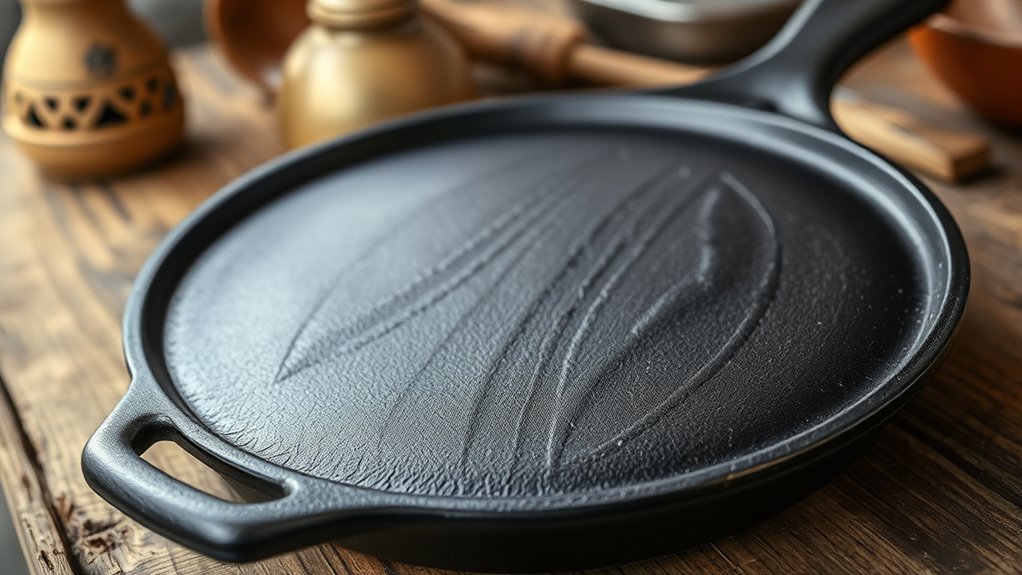
Choosing authentic cast iron cookware involves paying attention to its seasoning, construction, and maintenance needs. Start by inspecting the surface for even, smooth seasoning; a well-seasoned cast iron develops a natural non-stick surface that improves with use. To maintain its performance, avoid soaking or using harsh soaps, which can strip the seasoning and cause rust. Always preheat your pan gradually to prevent warping or cracking, ensuring even heat distribution. After cooking, dry the cookware thoroughly and apply a thin layer of oil to build and preserve the seasoning, boosting its non-stick qualities and longevity. Regular maintenance, including re-seasoning when needed, keeps your cast iron durable and rust-free, ensuring it remains a reliable, long-lasting tool in your kitchen.
Frequently Asked Questions
What Is the Longest Lasting Cookware Material?
You’re wondering about the longest-lasting cookware material. Cast iron stands out because it can last over 300 years with proper care. You’ll find that it resists warping, cracking, and corrosion, unlike many modern options. Its seasoning gets better over time, providing excellent non-stick properties. Plus, cast iron can handle high heat and versatile cooking methods, making it a durable choice that can become a treasured heirloom for generations.
What Is the Oldest Type of Cookware?
Did you know that the oldest cookware dates back over 9,000 years? You’re exploring the origins of cooking, and it’s fascinating to learn that early civilizations used clay or ceramic pots for food preparation. These ancient vessels, handmade and sometimes glazed, allowed for slow cooking that preserved flavor and nutrients. Your curiosity connects you to a tradition that’s lasted millennia, showcasing the enduring value of simple, durable materials in cooking.
What Is the Highest Quality Cookware?
You want to know the highest quality cookware, and the answer lies in traditional materials like cast iron, copper, and multi-ply stainless steel. These options have stood the test of time, offering durability, excellent heat retention, and precise temperature control. You’ll find them favored by professional chefs and home cooks alike because they perform reliably, last for generations, and often outperform many modern alternatives in the kitchen.
What Is the Healthiest Cookware Material?
When you ask about the healthiest cookware material, turn to cast iron. You can trust it because it’s naturally non-toxic, with no synthetic coatings or harmful chemicals. It adds beneficial iron to your food, is durable, and offers excellent heat retention. Plus, it’s versatile for various cooking methods and improves with age, making it a safe, eco-friendly choice that supports your health and cooking needs.
Conclusion
Embracing seasoned cast iron can gently guide you toward a kitchen tradition rooted in resilience and natural beauty. With a little care, this timeless cookware whispers stories of durability and safety, offering a quiet confidence in every meal. By choosing this age-old companion, you’re not just cooking—you’re nurturing a legacy that’s as sustainable as it is dependable, turning everyday cooking into a subtle act of reverence for history and nature alike.
